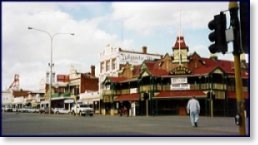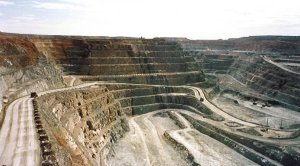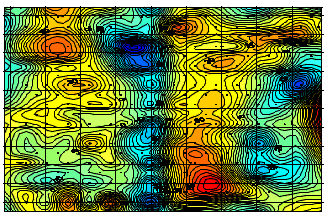Kalgoorlie, Australia - a microgravity case study
 KCGM operate one of the worlds largest gold mines, located in Western Australia. The open cast superpit is working towards a finished level of -600m. Extensive abandoned stope workings dating from the 1800s underlie the mine and present severe problems in terms of mine planning and production.
KCGM operate one of the worlds largest gold mines, located in Western Australia. The open cast superpit is working towards a finished level of -600m. Extensive abandoned stope workings dating from the 1800s underlie the mine and present severe problems in terms of mine planning and production.
KCGM had already tested several geophysical methods and commissioned us to carry out a microgravity pilot study to evaluate the techniques ability to:
-
locate and define the stope workings
-
assess the incorporation of the method into a production environment.
 We used an advanced digital terrain model to calculate the severe terrain correction which had to be applied to the data due to the 250m high 70 degree sidewalls.
We used an advanced digital terrain model to calculate the severe terrain correction which had to be applied to the data due to the 250m high 70 degree sidewalls.
The residual microgravity plot indicated the location of significant stope traces running N-S across the site area. Subsequent processing delineated a further bifurcation in the old workings. Gravity acquisition took place over a 10 day period, requiring the use of roped access techniques and nighttime working within the fully operational pit environment. The high-resolution microgravity was acquired within 200m of the working face and drilling operations. Field processed data were transmitted daily to the UK.
 Residual gravity plots were mailed the following day to Kalgoorlie for commencement of the operations. Ground truth was provided by the drilling of anomalies identified from the microgravity survey and the use of a spinning laser which was lowered down the borehole to generate a 3D model of the cavities. The reliability, accuracy and success of the microgravity method to locate and define old stope workings, in conjunction with the acquisition of high-quality data in the operational pit environment, has resulted in the technique being adopted for the pits remaining life.
Residual gravity plots were mailed the following day to Kalgoorlie for commencement of the operations. Ground truth was provided by the drilling of anomalies identified from the microgravity survey and the use of a spinning laser which was lowered down the borehole to generate a 3D model of the cavities. The reliability, accuracy and success of the microgravity method to locate and define old stope workings, in conjunction with the acquisition of high-quality data in the operational pit environment, has resulted in the technique being adopted for the pits remaining life.

